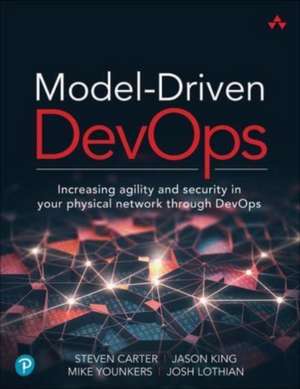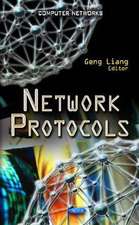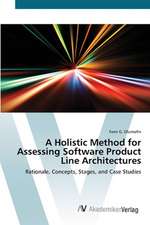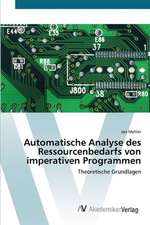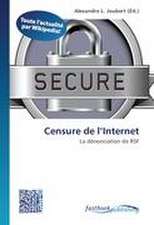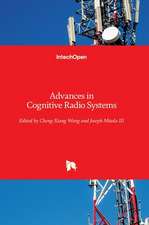Model-Driven Devops
Autor Steven Carter, Jason King, Mike Younkers, Josh Lothianen Limba Engleză Paperback – 3 sep 2022
Develop Network Infrastructure More Rapidly, and Operate It More Effectively
Using model-driven DevOps and the Infrastructure as Code (IaC) paradigm, teams can develop and operate network infrastructure more quickly, consistently, and securely--growing agility, getting to market sooner, and delivering more value. Now, two leading practitioners walk you step by step through successfully implementing model-driven DevOps for infrastructure. In this practical guide, they share lessons learned, help you avoid common pitfalls, and illuminate key differences between DevOps for infrastructure and conventional application-based DevOps.
You'll learn why network infrastructure operations must change, what needs to change, and how to work together to change it. The authors guide you through creating consistent data models to manage massive numbers of network elements, organizing huge quantities of network data, and applying DevOps to infrastructure repeatably and consistently. Your journey includes a complete, hands-on reference implementation, detailed use cases, many examples based on open source tools, and sample code downloadable at GitHub.
* Normalize and organize network infrastructure data consistently, to gain the same benefits from DevOps as cloud operators do * Replace legacy command lines with APIs, then leverage and scale them * Use configuration management, templates, and other tools to program infrastructure without coding * Safely implement Continuous Integration/Continuous Deployment for infrastructure* Succeed with key human factors: break down silos, change culture, and address skills gaps
Whether you're a network or cybersecurity engineer, architect, manager, or leader, this guide will help you suffuse all your network operations with greater efficiency, security, responsiveness, and resilience.Preț: 268.15 lei
Preț vechi: 335.19 lei
-20% Nou
Puncte Express: 402
Preț estimativ în valută:
51.32€ • 55.72$ • 43.11£
51.32€ • 55.72$ • 43.11£
Carte disponibilă
Livrare economică 02-16 aprilie
Livrare express 18-22 martie pentru 25.84 lei
Preluare comenzi: 021 569.72.76
Specificații
ISBN-13: 9780137644674
ISBN-10: 0137644671
Pagini: 192
Dimensiuni: 174 x 224 x 12 mm
Greutate: 0.31 kg
Editura: Pearson Education
ISBN-10: 0137644671
Pagini: 192
Dimensiuni: 174 x 224 x 12 mm
Greutate: 0.31 kg
Editura: Pearson Education
Cuprins
Chapter 1: A Lightbulb Goes Off
Enterprise IT as a Source of Risk to the Business
Observations of a Train Wreck
DevOps Seems Like a Better Way
What Is DevOps?
Automation
Infrastructure as Code
CI/CD
Apps vs. Infrastructure
Harnessing Automation-at-Scale
Why Are Enterprise IT Departments Not Adopting DevOps?
Human Factors
Business Factors
Summary
Chapter 2: A Better Way
The Goal: Business Transformation
Constraints-Based IT
Business Transformation
DevOps in Action
Why Model-Driven DevOps?
Network Infrastructure Is Different
What Is Model-Driven DevOps?
What Is a Data Model?
Source of Truth
DevOps as a Framework
DevSecOps: Baked-In Security
Summary
Chapter 3: Consumable Infrastructure
APIs
Why API over CLI?
Platforms
Physical Hardware Provisioning
Consolidated Control Point
Northbound vs. Southbound APIs
API and Feature Normalization
Fabricwide Services
Scalability
Summary
Chapter 4: Infrastructure as Code
Why Infrastructure as Code?
Source of Truth
Data Models
Common IaC Tools
Organization
Types of Source of Truth
Code
Data Flow
Summary
Chapter 5: Continuous Integration/Continuous Deployment
CI/CD Overview
Applications vs. Infrastructure
CI/CD in Action
Source Code Management
Core Features
Collaboration Features
SCM Summary
Continuous Integration Tools
CI Engines
How They Work
Sample Workflow
Infrastructure Simulation Tools
Cisco Modeling Labs
Test and Validation
Linting
Schema/Model Validation
Functional Testing
Test and Validation Summary
Continuous Deployment
Continuous Monitoring
Summary
Chapter 6: Implementation
Model-Driven DevOps Reference Implementation
The Goal
DevOps Roadmap
Architecture
Network as an Application
Consistency
Simulation
Automation
Creating a Source of Truth
Moving Data
MDD Source of Truth
Automation Tooling
MDD Data
Automation Runner
Cisco Network Services Orchestrator
Testing
Linting
Snapshotting the Test Network
Data Validation and State Checking
Data Validation
Pushing Data to the Devices
State Checking
Restore
Continuous Integration Workflow Summary
Deployment
Scale
Starting Workflows
Summary
Chapter 7: Human Factors
Culture and the Need for Change
Start with the Why
Organization
Leadership
Role Models
Building a Team
Break Down the Silos
Community
New Tools
Summary of Organization-Level Changes
Individual
Programming vs. Automation
Version Control Tools
Data Formats
APIs
Templating
Linux/UNIX
Wait! Where Do I Fit In?
Summary
9780137644674 TOC 6/23/2022
Enterprise IT as a Source of Risk to the Business
Observations of a Train Wreck
DevOps Seems Like a Better Way
What Is DevOps?
Automation
Infrastructure as Code
CI/CD
Apps vs. Infrastructure
Harnessing Automation-at-Scale
Why Are Enterprise IT Departments Not Adopting DevOps?
Human Factors
Business Factors
Summary
Chapter 2: A Better Way
The Goal: Business Transformation
Constraints-Based IT
Business Transformation
DevOps in Action
Why Model-Driven DevOps?
Network Infrastructure Is Different
What Is Model-Driven DevOps?
What Is a Data Model?
Source of Truth
DevOps as a Framework
DevSecOps: Baked-In Security
Summary
Chapter 3: Consumable Infrastructure
APIs
Why API over CLI?
Platforms
Physical Hardware Provisioning
Consolidated Control Point
Northbound vs. Southbound APIs
API and Feature Normalization
Fabricwide Services
Scalability
Summary
Chapter 4: Infrastructure as Code
Why Infrastructure as Code?
Source of Truth
Data Models
Common IaC Tools
Organization
Types of Source of Truth
Code
Data Flow
Summary
Chapter 5: Continuous Integration/Continuous Deployment
CI/CD Overview
Applications vs. Infrastructure
CI/CD in Action
Source Code Management
Core Features
Collaboration Features
SCM Summary
Continuous Integration Tools
CI Engines
How They Work
Sample Workflow
Infrastructure Simulation Tools
Cisco Modeling Labs
Test and Validation
Linting
Schema/Model Validation
Functional Testing
Test and Validation Summary
Continuous Deployment
Continuous Monitoring
Summary
Chapter 6: Implementation
Model-Driven DevOps Reference Implementation
The Goal
DevOps Roadmap
Architecture
Network as an Application
Consistency
Simulation
Automation
Creating a Source of Truth
Moving Data
MDD Source of Truth
Automation Tooling
MDD Data
Automation Runner
Cisco Network Services Orchestrator
Testing
Linting
Snapshotting the Test Network
Data Validation and State Checking
Data Validation
Pushing Data to the Devices
State Checking
Restore
Continuous Integration Workflow Summary
Deployment
Scale
Starting Workflows
Summary
Chapter 7: Human Factors
Culture and the Need for Change
Start with the Why
Organization
Leadership
Role Models
Building a Team
Break Down the Silos
Community
New Tools
Summary of Organization-Level Changes
Individual
Programming vs. Automation
Version Control Tools
Data Formats
APIs
Templating
Linux/UNIX
Wait! Where Do I Fit In?
Summary
9780137644674 TOC 6/23/2022
Notă biografică
Steven Carter has more than 25 years of industry experience working in large universities, government research and development laboratories, and private sector companies. He has been a speaker at several industry conferences and written blogs and articles in technical journals. He has spent time as a system administrator running some of the worlds largest supercomputers and a network engineer building out the worlds first SDN network for the Department of Energy. In addition, Steven has a wide range of experience in networking, including operations, embedded software development, and sales. He has spent the past 5 years working for Red Hat Ansible and Cisco Systems consulting and coding for many of the worlds largest organizations as they modernize and secure their operations by incorporating DevOps. He currently works as a principal DevOps engineer for Cisco Systems creating CI/CD pipelines for deploying cloud applications and network infrastructure in secure and classified environments. He holds a BS in computer engineering, an MS in computer science, an MBA, and a CCIE in routing and switching.
Jason King is a solutions architect at Cisco, supporting the public sector community. In his 11 years at Cisco, he has focused on cloud, automation, programmability, and HPC. Prior to joining Cisco, he spent 10 years building and tuning some of the worlds largest HPC clusters at Lawrence Livermore National Laboratory. He holds an MS in computer science and a CCIE in routing and switching.